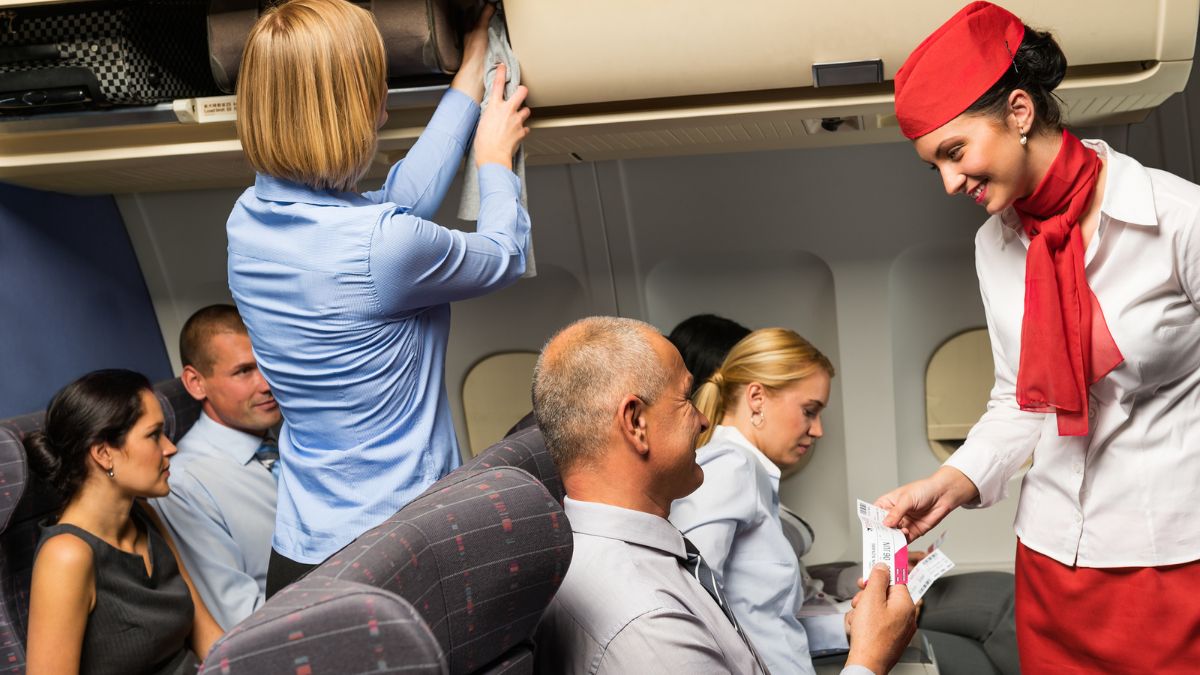Can a Flight Attendant Legally Make You Change Seats? Exploring Airline Protocols

As participants in Amazon Associates and other programs, we earn from qualifying purchases. This comes at no additional cost to you. For more details, see our Affiliate Disclosure.
Navigating the skies, every traveler hopes for a smooth journey, especially when they’ve secured their preferred seat on the plane. Whether it’s for the view, the extra space, or the proximity to essential amenities, our chosen spot holds significant value. But what happens when a flight attendant approaches with a request to switch seats? It’s a situation that raises eyebrows and prompts the question, can a flight attendant legally make you move? In this exploration, we’ll unravel the intricacies of airline protocols and find out.
HIGHLIGHTS
- Flight attendants can legally request passengers to change seats based on several factors, primarily revolving around safety and operational needs.
- Passengers have rights when flying, but these rights are balanced with the airline’s responsibilities to ensure safety and efficiency.
- If passengers believe their rights have been violated, they should document the situation, understand their rights, and approach airline customer service for redress.
- Seeking mediation or contacting regulatory authorities can be an avenue for passengers if direct discussions with the airline do not yield satisfactory results.
Airline Protocols and Seating Arrangements: The Basics
Air travel, with its intricate web of rules and procedures, is governed by a mix of international conventions, national laws, and airline-specific policies. At the heart of these are the principles of safety, security, and efficient service. When it comes to seating arrangements on flights, there’s a blend of these principles in play.
1. Pre-assigned Seating: Most airlines offer passengers the ability to choose their seat in advance, either during booking or at the time of check-in. While this gives passengers a semblance of control, it’s subject to change. These changes can occur due to a variety of reasons such as aircraft swaps, which might result in a different seating layout.
2. Overbooking: Some airlines overbook flights, anticipating a certain number of no-shows. On occasions when more passengers show up than there are seats, airlines might ask for volunteers to change flights. If there aren’t enough volunteers, they may need to reseat passengers based on specific criteria, like fare type or loyalty status.
3. Safety and Security: Flight attendants are trained to ensure the safety and security of all passengers. If there’s a situation where seating needs to be rearranged for security reasons or to balance the weight of the plane, they are empowered to do so.
4. Special Needs and Assistance: Passengers with disabilities, young children traveling alone, or those needing extra assistance might be given priority or specific seating to cater to their needs. This sometimes requires other passengers to switch seats.
5. Cabin Classes: Every aircraft has different cabin classes, like economy, premium economy, business, and first class. Passengers are strictly seated based on their ticket’s cabin class. If someone mistakenly occupies a seat in a higher cabin class, they will be asked to move to their assigned spot.
6. Seat Maintenance: Occasionally, a seat might be out of service due to malfunctioning entertainment systems, reclining features, or even cleanliness issues. If this happens, passengers occupying those seats might be moved to another location if available.
While passengers have a reasonable expectation to occupy the seat they’ve chosen or been assigned, several scenarios might prompt a change. It’s always beneficial for passengers to be aware of these possibilities and know their rights and the reasoning behind such decisions.
Safety First: Situations That Warrant Seat Changes
The primary concern for any airline is the safety and security of its passengers, crew, and aircraft. Sometimes, ensuring this safety means asking passengers to change their seats. These scenarios, while possibly inconvenient for the traveler, are rooted in tried and tested safety protocols. Here are some of the primary reasons behind such decisions:
1. Weight and Balance: The proper distribution of weight is crucial for the aircraft’s safe operation. Especially in smaller planes, passengers might be asked to move to ensure that the aircraft is balanced correctly for takeoff, cruising, and landing.
2. Emergency Exit Rows: Seats located near emergency exits come with additional responsibilities. Passengers seated here may be required to assist in the event of an emergency. Therefore, those who do not meet the criteria – such as minors, people with physical disabilities, or those unable to understand instructions – will be asked to change seats.
3. Potential Security Threats: If a flight attendant or a member of the crew perceives a passenger as a potential threat, they may be reseated or, in extreme cases, removed from the flight. This is to ensure the safety of everyone on board.
4. Medical Emergencies: If a passenger falls ill during a flight, they might need to be reseated to receive proper medical attention. In such cases, adjacent passengers might be asked to move to facilitate care.
5. Disruptive Behavior: Passengers who display disruptive or aggressive behavior, whether due to intoxication, stress, or other reasons, might be moved to a location where they can be more closely monitored by the flight crew.
6. Equipment Interference: Modern aircraft are equipped with an array of sensitive instruments. If a passenger’s electronic device or other equipment interferes with these instruments, they might be asked to switch it off or, in rare cases, change seats.
7. Cabin Crew’s Discretion: Based on their training and experience, the cabin crew might identify other unforeseen safety issues and ask passengers to adjust seating accordingly.
In all these situations, the guiding principle is clear: safety overrides convenience. Passengers should remember that any request to change seats, especially when rooted in safety concerns, is made in the best interest of everyone on board.
Balancing Passenger Rights and Airline Needs: A Delicate Dance
Every passenger boarding a flight does so with a set of rights and expectations. They’ve perhaps paid a premium for a specific seat, or they’ve carefully selected a spot that meets their needs. Their right to that seat and to a comfortable journey is paramount. Yet, the airlines have their set of responsibilities too, which sometimes necessitates making adjustments that may not always align with passengers’ initial expectations.
In the vast matrix of air travel, airlines need to consider operational logistics, safety protocols, and optimal service delivery. These considerations might sometimes lead to reseating passengers, even if reluctantly. It’s a delicate balance, where the airline’s primary goal is to ensure that everyone reaches their destination safely, but without unduly compromising the passenger experience.
Legal frameworks in various countries, and internationally, recognize the importance of passengers’ rights. Regulations often stipulate compensation or alternative arrangements if there are significant disruptions. However, these rights are not absolute, and they do come with certain limitations, especially when safety is a concern.
For passengers, it’s essential to be aware of their rights, but also to understand the broader picture. Flight attendants and crew are not merely enforcing rules; they are often making real-time decisions in a dynamic environment. Their objective? To ensure that the balance between individual rights and collective safety and comfort is always maintained. It’s a dance, a careful choreography that seeks harmony in the skies.
What to Do If Asked to Change Seats: Practical Tips and Advice
Finding yourself asked to switch seats on a flight can be unexpected, especially when you’ve carefully chosen your position. The key is to approach such situations with understanding and practicality, balancing your needs with the reasons provided by the airline. Here’s how:
- Stay Calm and Polite: Understand that the request often isn’t personal. An emotional reaction might complicate matters further. Flight attendants are trained professionals who often prioritize safety and operational needs. Responding with courtesy can lead to a more constructive resolution.
- Ask for the Reason: Knowing why you’re being asked to move can provide clarity and make the request feel less arbitrary. Flight adjustments may be due to several reasons, ranging from accommodating families to balancing the aircraft’s weight.
- Communicate Specific Needs: If you have reasons for your seat preference, like a medical condition, share that information. Flight attendants can use this information to find a suitable alternative or perhaps reconsider the move.
- Inquire About Compensation: If the switch involves a downgrade or significant inconvenience, ask if the airline offers any compensatory measures. Airlines might provide perks such as vouchers, meal upgrades, or extra frequent flyer miles as a gesture of goodwill.
- Know Your Rights: While you should be aware of your passenger rights, recognize there are limits, especially concerning safety and security. Regulations might stipulate compensation or specific considerations in the event of significant disruptions.
- Document and Give Feedback: If you believe your rights were overlooked, note the details and consider approaching the airline post-flight. Airlines often use passenger feedback to improve, and you might receive an apology or compensation for any oversight.
By adopting a collaborative approach and understanding the dynamics of air travel, passengers can navigate seat-change requests more efficiently, ensuring a comfortable journey for all.
Seeking Redress: Steps to Take if You Feel Your Rights Were Violated
While airlines operate with the primary objective of safety and operational efficiency, there are occasions when passengers might feel that their rights have been violated. If you believe you’ve been unfairly treated or unduly inconvenienced, there are steps you can take to seek redress:
- Document the Situation: Before disembarking, jot down all relevant details. This includes the names of the flight attendants involved, the nature of the incident, the time and date, and any communication exchanged regarding the matter. Photographs or video recordings, where appropriate and without violating privacy regulations, can also be helpful.
- Understand Your Rights: Familiarize yourself with the airline’s Contract of Carriage, which outlines terms and conditions of service. Additionally, review any applicable passenger rights regulations specific to the country or region. For instance, the EU has Regulation 261/2004 which covers compensation and assistance to passengers in the event of denied boarding and flight cancellations or delays.
- Approach Airline Customer Service: Start by addressing your concerns directly with the airline. Reach out to their customer service department, either at the airport or through their official channels, providing a detailed account of the incident and any supporting evidence.
- Lodge a Formal Complaint: If the initial response is unsatisfactory, you may need to file a formal complaint with the airline. Ensure you outline the redress you are seeking, be it an apology, compensation, or another form of rectification.
- Seek Mediation or Arbitration: Some airlines or countries have mediation or arbitration services for resolving disputes between airlines and passengers. This offers a neutral platform where both parties can discuss the issue and find a resolution.
- Contact Regulatory Authorities: If you’re unable to find a resolution directly with the airline, approach aviation regulatory bodies or consumer protection agencies in the relevant jurisdiction. They can provide guidance, and in some cases, may investigate or mediate on your behalf.
- Consider Legal Action: As a last resort, if you believe your rights have been severely violated and other avenues have not yielded a satisfactory response, you might consider seeking legal counsel and pursuing the matter in court.
While seeking redress can sometimes be a lengthy process, it’s essential for passengers to know they have avenues available if they believe their rights have been compromised. The key is to approach the situation with clarity, patience, and persistence.






